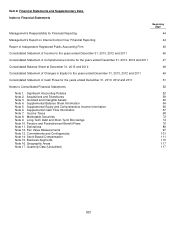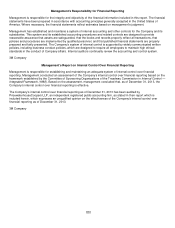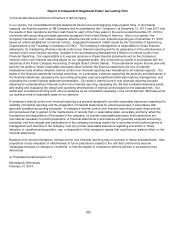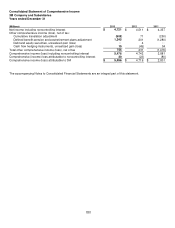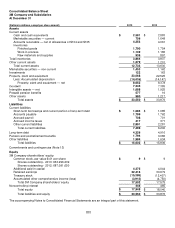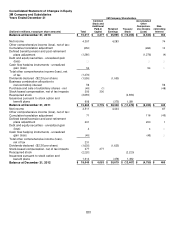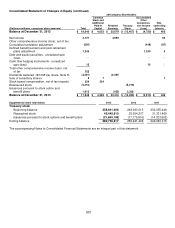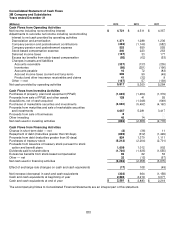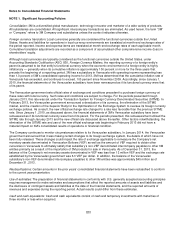3M 2013 Annual Report Download - page 59
Download and view the complete annual report
Please find page 59 of the 2013 3M annual report below. You can navigate through the pages in the report by either clicking on the pages listed below, or by using the keyword search tool below to find specific information within the annual report.53
Marketable securities: The classification of marketable securities as current or non-current is dependent upon
management’s intended holding period, the security’s maturity date and liquidity considerations based on market
conditions. If management intends to hold the securities for longer than one year as of the balance sheet date, they are
classified as non-current. 3M reviews impairments associated with its marketable securities in accordance with the
measurement guidance provided by ASC 320, Investments-Debt and Equity Securities, when determining the
classification of the impairment as “temporary” or “other-than-temporary”. A temporary impairment charge results in an
unrealized loss being recorded in the other comprehensive income component of shareholders’ equity. Such an
unrealized loss does not reduce net income for the applicable accounting period because the loss is not viewed as other-
than-temporary. The factors evaluated to differentiate between temporary and other-than-temporary include the projected
future cash flows, credit ratings actions, and assessment of the credit quality of the underlying collateral, as well as other
factors.
Investments: Investments primarily include equity method, cost method, and available-for-sale equity investments.
Available-for-sale investments are recorded at fair value. Unrealized gains and losses relating to investments classified as
available-for-sale are recorded as a component of accumulated other comprehensive income (loss) in shareholders’
equity.
Other assets: Other assets include deferred income taxes, product and other insurance receivables, the cash surrender
value of life insurance policies, and other long-term assets. Investments in life insurance are reported at the amount that
could be realized under contract at the balance sheet date, with any changes in cash surrender value or contract value
during the period accounted for as an adjustment of premiums paid. Cash outflows and inflows associated with life
insurance activity are included in “Purchases of marketable securities and investments” and “Proceeds from maturities
and sale of marketable securities and investments,” respectively.
Inventories: Inventories are stated at the lower of cost or market, with cost generally determined on a first-in, first-out
basis.
Property, plant and equipment: Property, plant and equipment, including capitalized interest and internal engineering
costs, are recorded at cost. Depreciation of property, plant and equipment generally is computed using the straight-line
method based on the estimated useful lives of the assets. The estimated useful lives of buildings and improvements
primarily range from 10 to 40 years, with the majority in the range of 20 to 40 years. The estimated useful lives of
machinery and equipment primarily range from three to 15 years, with the majority in the range of five to 10 years. Fully
depreciated assets are retained in property and accumulated depreciation accounts until disposal. Upon disposal, assets
and related accumulated depreciation are removed from the accounts and the net amount, less proceeds from disposal, is
charged or credited to operations. Property, plant and equipment amounts are reviewed for impairment whenever events
or changes in circumstances indicate that the carrying amount of an asset (asset group) may not be recoverable. An
impairment loss would be recognized when the carrying amount of an asset exceeds the estimated undiscounted future
cash flows expected to result from the use of the asset and its eventual disposition. The amount of the impairment loss
recorded is calculated by the excess of the asset’s carrying value over its fair value. Fair value is generally determined
using a discounted cash flow analysis.
Conditional asset retirement obligations: A liability is initially recorded at fair value for an asset retirement obligation
associated with the retirement of tangible long-lived assets in the period in which it is incurred if a reasonable estimate of
fair value can be made. Conditional asset retirement obligations exist for certain long-term assets of the Company. The
obligation is initially measured at fair value using expected present value techniques. Over time the liabilities are accreted
for the change in their present value and the initial capitalized costs are depreciated over the remaining useful lives of the
related assets. The asset retirement obligation liability was $90 million and $86 million at December 31, 2013 and 2012,
respectively.
Goodwill: Goodwill is the excess of cost of an acquired entity over the amounts assigned to assets acquired and liabilities
assumed in a business combination. Goodwill is not amortized. Goodwill is tested for impairment annually in the fourth
quarter of each year, and is tested for impairment between annual tests if an event occurs or circumstances change that
would indicate the carrying amount may be impaired. Impairment testing for goodwill is done at a reporting unit level, with
all goodwill assigned to a reporting unit. Reporting units are one level below the business segment level, but can be
combined when reporting units within the same segment have similar economic characteristics. 3M did not combine any
of its reporting units for impairment testing. An impairment loss generally would be recognized when the carrying amount
of the reporting unit’s net assets exceeds the estimated fair value of the reporting unit. The estimated fair value of a
reporting unit is determined using earnings for the reporting unit multiplied by a price/earnings ratio for comparable
industry groups, or by using a discounted cash flow analysis.


